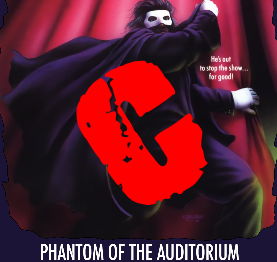Phantom of the Auditorium (1994)
by R.L. Stine

Ah, the Goosebumps series. My ten-year-old self found it absolutely terrifying, and often restricted herself to only reading one book at a time so as to keep from overloading herself with too much panic to handle. Obviously, my adult wussiness when it comes to horror is not a new phenomenon; these, and many other patently ridiculous horror stories for kids, scared the bejeezus out of me, even when their premises were beyond laughable (there was one where a sponge from under the kitchen sink was possessed and evil. And I was terrified by it).
This series hits pretty much every major horror archetype out there, so it's no surprise that a version based on the Phantom story came along. This book's in the grand tradition of horror Phantoms starting with Lon Chaney's in 1925, and uses a lot of the same tropes and ideas, just rendered down for a younger audience.
The plot of the actual book isn't all that strange; the kids are putting on a play entitled The Phantom at their middle school (dude, these kids did Guys and Dolls last year, too... where the hell do they go to middle school?), and some mysterious agent is trying to sabotage them. There is a rumor that the play was performed seventy years ago, but the boy playing the Phantom disappeared without a trace and the play is supposedly cursed now. Naturally, the kids are determined to poke around and find out the truth of the matter.
Much more hilarious, however, is the plot of this play they're performing. It is ZANY. There's a theater owned by a man named Carlo (....Carlotta? Is that you?), and his daughter is named Esmerelda (how did poor old Victor Hugo get dragged into this?) and is the Christine character. She doesn't believe her father's stories about a Phantom in the theater, but when she meets said Phantom, masked and living underground, she falls madly in love with him and they plan to run away together. But, alas! Her handsome, rich boyfriend Eric (!?!?!) finds out about this plan and makes his way down to the Phantom's lair, where the two fight and, eventually, Eric kills the Phantom, leaving Esmerelda heartbroken and the Phantom's ghost haunting the theater for all eternity.
That, ladies and gentlemen, is epic. Somehow, this version involves Christine, as the daughter of a mysterious alternative universe version of Carlotta who runs the theater, falling in love with the nameless Phantom who is murdered by Raoul who is apparently ALSO the Phantom, and then everybody cries. Stine, level with me. You are absolutely just fucking with us, right? You didn't want to follow the mold of the popular versions that were already out, so you just decided to do whatever the hell you felt like, didn't you? I just kept reading, endlessly fascinated - not by the very simple and choppy prose, or by the one-dimensional kids' characters, but because I had to know if things were going to get more ridiculous. And they did! The book did not disappoint! This is some of the best weird shit I have ever seen! This is quality weird shit here.
There are parallels intentionally set up in the regular plot as well - Brooke, unexpectedly playing the lead, is obviously a Christine to her best friend Zeke's Erik, while the jealous Tina is a Carlotta stand-in and quiet, easily-frightened Brian rounds things out with a handsome Raoul kind of a dynamic. But none of that is explored or anything, since I doubt Stine has any interest in metaphor in his wee penny-dreadful-for-kids.
There are actually a few whispers of influence from other sources present; the script of the play is found abandoned in the depths of the basement, which is reminiscent of Christine discovering the last surviving copy of Don Juan Triumphant in the 1989 Little/Englund film, while Zeke's love of rubber masks and fantastic makeup may be a nod to Chaney and Brooke's unmasking of the Phantom onstage in the middle of the play is borrowed from Lloyd Webber's musical. There's even a double-Phantom idea (one is a homeless man who lives beneath the school in an abandoned janitor's closet, while the other is actually the ghost of the deceased boy), which has been explored in such cinematic gems as the 1974 Levitt/Cassidy movie and the 1979 Savage/Joboulian film.
But who cares about that when there's so much unexplained homage to weirdness going on? This is so gleefully random. I really think that Stine just borrowed the elements of the original story that seemed to fit his purposes best, and made everything else up, with great results for the intended audience.